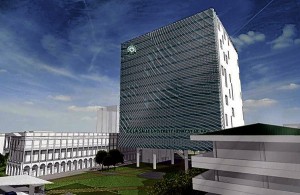
De La Salle University concludes its centennial school year (2011-2012) with the inauguration of a new eco-friendly building and with the staging of two productions.
On June 15, the Henry Sy Sr. Centennial Hall will have its blessing. That same day, there will be a performance of “Cultura Verde” at the building’s lobby, a showcase featuring different student and faculty dance, chorale and orchestra groups from all 17 Lasallian schools.
The day ends with a concert, “Lasallianation,” directed by alumnus singer and TV personality Randy Santiago. Theater actors Gian Magdangal and Carlo Orosa are just two of several guest alumni performers.
Designed by Leandro Locsin Partners with interiors by Ascuncion-Berenguer, the building is named for retail magnate Henry Sy Sr., whose donation jumpstarted its construction.
Symbolizing the university’s “continuous and growing role in Philippine education,” the building’s design has been anchored on the idea of a “habitable tree.” Pillars punctuate the ground level like tree trunks holding up a canopy and aluminum fins that serve as cladding evoke stylized leaf blades.
“The concept represents the university as nurturing,” says DLSU president and chancellor Br. Narciso Erguiza Jr. “As well as showing the university’s commitment to environmental responsibility and sustainability.”
Eco-friendly
It will be the first academic structure to be rated with the Philippine Green Building Council’s Building Ecologically Responsive Design Excellence (Berde) standard, a measure of how “environment-friendly” a structure is, similar to the Leadership in Energy and Environmental Design (LEED) standard developed in the US.
Emphasis was placed on reducing the energy requirements of the building.
Solar panels will be located on the roof to convert sunlight into electricity for the building. Aside from providing a view of Manila Bay, the roof deck features a multipurpose gazebo amid a garden. “It’s partially covered with plants to improve the building’s insulation.”
The building will have a rainwater collecting system that stores rainwater to be used for flushing toilets. “Used water from sinks will also be collected and treated for reuse in toilets.”
To control the building’s microclimate more efficiently, windows will have double-glazed glass which reduces the heat transfer between the building’s internal and external environments.
The aluminum fins lining the building’s sides that face the sun’s path are not merely decorative. They’re positioned to redirect diffused daylight into the building while reducing the building’s direct heat gain. “It will allow us to use less artificial lighting during the day.”
Functions
The 15-story structure has earmarked most of its floors for a learning commons, which will include the university’s library and areas for “relaxation and interaction,” to serve the university’s average 17,000 students, faculty and staff every school year.
The university’s library started operations in 1956 with barely 10,000 books. Through the years, it has acquired up to more than 235,000 titles.
It houses a collection of Filipino-American writer Bienvenido Santos’s mementos and a mumismatic collection donated by philatelist Felipe Liao that contains items used as currency from the pre-Spanish era until the 1990s.
“The aim is to have one million books in the Learning Commons. There will be 48 small discussion rooms, as well as ‘quiet rooms,’ reading rooms, meeting rooms and even a bean bag area.”
In addition, there will be pocket indoor gardens, outdoor reading areas and wide-open spaces. “These areas are meant to support creativity and engage learners to generate new ideas.”
The university’s registrar’s office, admissions office, and accounting and finance office will all be relocated to this building to provide centralized access to students.
“With the Henry Sy Sr. Centennial Hall, we have a new icon that will be another symbol of our commitment to serve as a resource for God and country,” says Erguiza. “We look forward to seeing more scholars walk in this hall with passion, energy, and the desire and commitment to national development.”
Founded in 1911 in Paco before moving to its current location in Malate, the university is the first of 17 schools in the country run by the De La Salle Brothers of the Philippines, a Roman Catholic teaching congregation founded in France by Saint Jean-Baptiste de la Salle with schools all over the world.
“Cultura Verde” is on June 15, 6 p.m. at the Henry Sy Sr. Centennial Hall; “Lasallianation” is at 8 p.m. at Teresa Yuchengco Auditorium. Call 5244611 loc. 107 or e-mail centennialhallinquiries@dlsu.edu.ph.